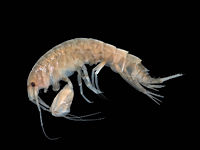Portal:Crustaceans
The Crustaceans Portal Crustaceans are a group of arthropods that are a part of the subphylum Crustacea (/krəˈsteɪʃə/), a large, diverse group of mainly aquatic arthropods including decapods (shrimps, prawns, crabs, lobsters and crayfish), seed shrimp, branchiopods, fish lice, krill, remipedes, isopods, barnacles, copepods, opossum shrimps, amphipods and mantis shrimp. The crustacean group can be treated as a subphylum under the clade Mandibulata. It is now well accepted that the hexapods (insects and entognathans) emerged deep in the Crustacean group, with the completed group referred to as Pancrustacea. The three classes Cephalocarida, Branchiopoda and Remipedia are more closely related to the hexapods than they are to any of the other crustaceans (oligostracans and multicrustaceans). The 67,000 described species range in size from Stygotantulus stocki at 0.1 mm (0.004 in), to the Japanese spider crab with a leg span of up to 3.8 m (12.5 ft) and a mass of 20 kg (44 lb). Like other arthropods, crustaceans have an exoskeleton, which they moult to grow. They are distinguished from other groups of arthropods, such as insects, myriapods and chelicerates, by the possession of biramous (two-parted) limbs, and by their larval forms, such as the nauplius stage of branchiopods and copepods. Most crustaceans are free-living aquatic animals, but some are terrestrial (e.g. woodlice, sandhoppers), some are parasitic (e.g. Rhizocephala, fish lice, tongue worms) and some are sessile (e.g. barnacles). The group has an extensive fossil record, reaching back to the Cambrian. More than 7.9 million tons of crustaceans per year are harvested by fishery or farming for human consumption, consisting mostly of shrimp and prawns. Krill and copepods are not as widely fished, but may be the animals with the greatest biomass on the planet, and form a vital part of the food chain. The scientific study of crustaceans is known as carcinology (alternatively, malacostracology, crustaceology or crustalogy), and a scientist who works in carcinology is a carcinologist. (Full article...) Selected article
The California spiny lobster, Panulirus interruptus, is a species of spiny lobster found in the eastern Pacific Ocean from Monterey Bay, California to the Gulf of Tehuantepec, Mexico. It typically grows to a length of 30 cm (12 in) and is a reddish-brown color with stripes along the legs, and has a pair of enlarged antennae but no claws. The interrupted grooves across the tail are characteristic for the species.
Females can carry up to 680,000 eggs, which hatch after 10 weeks into flat phyllosoma larvae. These feed on plankton before the metamorphosis into the juvenile state. Adults are nocturnal and migratory, living among rocks at depths of up to 65 m (213 ft), and feeding on sea urchins, clams, mussels and worms. The spiny lobster is eaten by various fish, octopuses and sea otters, but can defend itself with a loud noise produced by its antennae. The California spiny lobster is the subject of both commercial and recreational fishery in both Mexico and the United States, with sport fishermen using hoop nets and commercial fishermen using lobster traps. Did you know?
Selected biographyEdward J. Miers F.Z.S. F.L.S. (1851–1930) was a British zoologist and curator of the crustacean collection at the Natural History Museum in London. He contributed to the scientific reports from the Challenger expedition of 1872–1876, and described 32 new genera and at least 260 new species and subspecies of decapod crustaceans, along with four genera and 72 new species in other orders. Miers published his Catalogue of the stalk- and sessile-eyed Crustacea of New Zealand in 1876 and revised the Plagusiinae, Hippidae, Majidae, Squillidae and Idoteidae in monographs dated 1878–1881. He also reported on the collections donated by the Admiralty from a number of voyages, including the survey of the coast of Japan by H.M.S. Sylvia (1870–1877), an expedition to view the Transit of Venus in Kerguelen and Rodrigues (1874–1875), a survey of the Galápagos Islands by H.M.S. Petrel, Novaya Zemlya by H.M.S. Isbjorn (1879), Baron Hermann-Maltzan's voyage to Gorée in 1881, and the voyages of H.M.S. Alert to Patagonia and the Strait of Magellan (1881–1882). The upheavals at his workplace and the quantity of work to be done may have taken their toll on Miers, and he was "completely prostrated with illness" for three months. Miers was still working on material from the Alert expedition, when six boxes containing the crabs from the Challenger expedition arrived, sent by John Murray. Describing these crabs would be Miers' largest taxonomic work, one which was published in 1886 as Report on the Brachyura collected by H. M. S. Challenger during the years 1873–1876 in 1886. Miers' honorarium for this work was £63 (60 guineas). Selected image Nototropis falcatus (formerly Atylus falcatus) is a species of amphipod from sandy bottoms in the North Atlantic and North Sea. General imagesThe following are images from various crustacean-related articles on Wikipedia.
Crustacean lists
SubcategoriesRelated portalsWikiProjectsAssociated WikimediaThe following Wikimedia Foundation sister projects provide more on this subject:
Discover Wikipedia using portals
|





















































